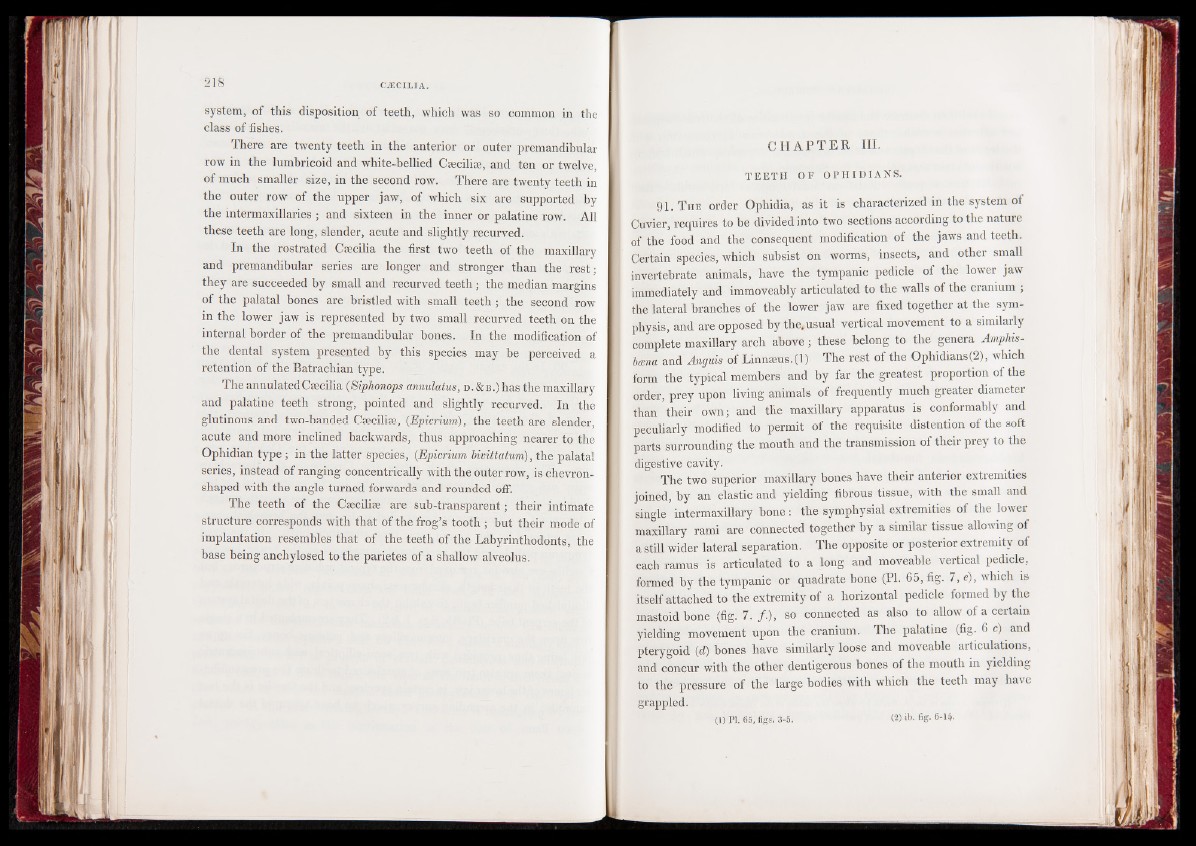
system, of this disposition of teeth, which was so common in the
class of fishes.
There are twenty teeth in the anterior or outer premandibular
row in the lumbricoid and white-bellied Cæciliæ, and ten or twelve,
of much smaller size, in the second row. There are twenty teeth in
the outer row of the upper jaw, of which six are supported by
the intermaxillaries ; and sixteen in the inner or palatine row. All
these teeth are long, slender, acute and slightly recurved.
In the rostrated Cæcilia the first two teeth of the maxillary
and premandibular series are longer and stronger than the rest;
they are succeeded by small and recurved teeth ; the median margins
of the palatal bones are bristled with small teeth ; the second row
in the lower jaw is represented by two small recurved teeth on the
internal border of the premandibular bones. In the modification of
the dental system presented by this species may be perceived a
retention of the Batrachian type.
The annulatedCæcilia (Siphonops anmlatus, d . & b .) has the maxillary
and palatine teeth strong, pointed and slightly recurved. In the
glutinous and two-handed Cæciliæ, (Epicrium), the teeth are slender,
acute and more inclined backwards, thus approaching nearer to the
Ophidian type ; in the latter species, (Epicrium bivittatum), the palatal
series, instead of ranging concentrically with the outer row, is chevronshaped
with the angle turned forwards and rounded off.
The teeth of the Cæciliæ are sub-transparent ; their intimate
structure corresponds with that of the frog’s tooth ; hut their mode of
implantation resembles that of the teeth of the Labyrinthodonts, the
base being anchylosed to the parietes of a shallow alveolus.
C H A P T E R III.
T E E TH OF O P H I D I A N S .
91. T he order Ophidia, as it is characterized in the system of
Cuvier, requires to be divided into two sections according to the nature
of the food and the consequent modification of the jaws and teeth.
Certain species, which subsist on worms, insects, and other small
invertebrate animals, have the tympanic pedicle of the lower jaw
immediately and immoveably articulated to the walls of the cranium ;
the lateral branches of the lower jaw are fixed together at the symphysis,
and are opposed by the,usual vertical movement to a similarly
complete maxillary arch above; these belong to the genera Amphis-
bwna and Anguis of Linnmus. (1) The rest of the Ophidians(2) , which
form the typical members and by far the greatest proportion of the
order, prey upon living animals of frequently much greater diameter
than their own; and the maxillary apparatus is conformably and
peculiarly modified to permit of the requisite distention of the soft
parts surrounding the mouth and the transmission of their prey to the
digestive cavity.
The two superior maxillary bones have their anterior extremities
joined, by an elastic and yielding fibrous tissue, with the small and
single intermaxillary bone: the symphysial extremities of the lower
maxillary rami are connected together by a similar tissue allowing of
a still wider lateral separation. The opposite or posterior extremity of
each ramus is articulated to a long and moveable vertical pedicle,
formed by the tympanic or quadrate bone (PI. 65, fig. 7, e), which is
itself attached to the extremity of a horizontal pedicle formed by the
mastoid bone (fig. 7. ƒ.), so connected as also to allow of a certain
yielding movement upon the cranium. The palatine (fig. 6 c) and
pterygoid (d) bones have similarly loose and moveable articulations,
and concur with the other dentigerous bones of the mouth in yielding
to the pressure of the large bodies with which the teeth may have
grappled.
(1) PI. 65, figs. 3-5. (2)ib. fig. 6-15-